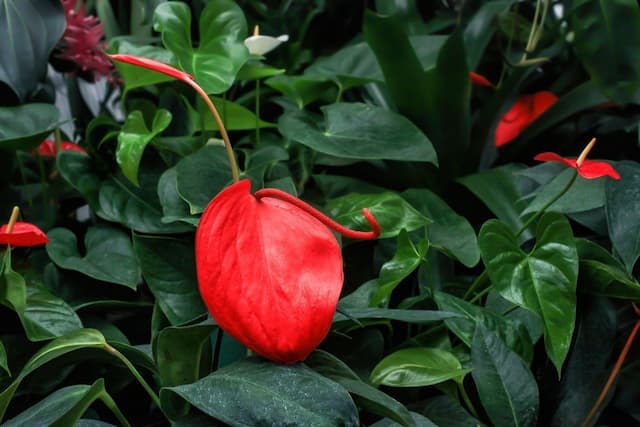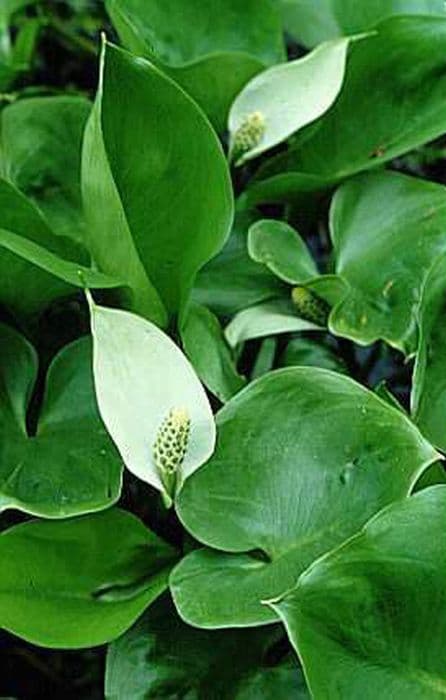Calla Lily Zantedeschia aethiopica

ABOUT
Zantedeschia aethiopica, commonly known as calla lily or arum lily, is a stunning plant with distinctive features that are easy to recognize. The calla lily is celebrated for its elegant, trumpet-shaped flowers, which are actually spathes. These spathes are large, showy, and usually pure white, enveloping a finger-like central spadix that carries the true tiny flowers. The spadix is typically a striking yellow color, providing a beautiful contrast against the white spathe. The leaves of the calla lily are glossy and arrow-shaped, with a rich green color, adding to the plant's attractive appearance. They emerge from the base of the plant on long stalks and tend to have a wavy or undulating edge, making the foliage quite decorative in its own right. This plant exudes simplicity and beauty, with its flowers gently curving and providing an air of sophistication and grace, which is why it's often used in wedding bouquets and elegant arrangements. The calla lily's appearance makes it a popular choice for gardens and as a potted plant indoors, where its showy spathes can be admired up close.
About this plant
 Names
NamesFamily
Araceae
Synonyms
Calla Lily, Arum Lily, Lily of the Nile, African White Lily, White Arum, Trumpet Lily, Easter Lily.
Common names
Richardia africana, Richardia aethiopica, Colocasia aethiopica, Calla aethiopica, Peltandra aethiopica.
 Toxicity
ToxicityTo humans
The most common common name for Zantedeschia aethiopica is calla lily. Calla lily is considered toxic to humans if ingested. The plant contains insoluble calcium oxalate crystals which can cause irritation to the mouth and gastrointestinal tract. Symptoms of poisoning may include intense burning and irritation of the mouth, lips, and tongue, excessive drooling, difficulty swallowing, and possible swelling of the throat that can lead to difficulty breathing. In severe cases, gastrointestinal symptoms such as vomiting and diarrhea may also occur.
To pets
The most common common name for Zantedeschia aethiopica is calla lily. Calla lily is toxic to pets such as cats and dogs if ingested. The plant contains insoluble calcium oxalate crystals, which, when chewed or bitten into, release these crystals causing tissue penetration and irritation. Symptoms of poisoning in pets might include oral pain, pawing at the mouth, drooling, foaming, vomiting, difficulty swallowing, and decreased appetite. Severe swelling of the oral tissues can potentially lead to difficulty breathing. Prompt veterinary attention is recommended if a pet ingests any part of the plant.
 Characteristics
CharacteristicsLife cycle
Perennials
Foliage type
Evergreen
Color of leaves
Green
Flower color
White
Height
2-3 feet (60-90 cm)
Spread
1-2 feet (30-60 cm)
Plant type
Herb
Hardiness zones
8
Native area
South Africa
Benefits
 General Benefits
General Benefits- Ornamental Value: The plant, commonly known as Calla Lily, provides aesthetic appeal to gardens and landscapes with its striking white spathe and lush green foliage.
- Easy Maintenance: Calla Lilies require minimal care once established, making them suitable for gardeners of all skill levels.
- Water-loving: They thrive in moist environments and can be used to beautify ponds or water gardens.
- Cut Flower Usage: The long-lasting blooms are popular in floral arrangements and bouquets due to their elegance and form.
- Symbolism and Tradition: They are often associated with purity and sympathy, making them appropriate for events like weddings and funerals.
- Versatility in Landscaping: These plants can be grown in borders, as solitary specimens, or in containers, adding versatility in design options.
- Attracts Pollinators: While in bloom, Calla Lilies attract bees and other pollinators, contributing to the health of the garden ecosystem.
- Deer-Resistant: They are not a preferred food source for deer, which helps prevent damage to them in areas where deer are present.
 Medical Properties
Medical Properties- Anti-inflammatory: Zantedeschia aethiopica has been reported to have anti-inflammatory properties.
- Analgesic: Some studies suggest it has pain-relieving effects.
- Wound Healing: It may be used in the context of traditional medicine for its wound healing properties.
- Antimicrobial: Extracts from the plant have shown antimicrobial activity against certain pathogens.
 Air-purifying Qualities
Air-purifying QualitiesThis plant is not specifically known for air purifying qualities.
 Other Uses
Other Uses- Zantedeschia aethiopica, commonly known as Calla Lily, can be used for dye production; the pigments extracted from its spathe are sometimes used in art and fabric dyeing.
- Calla Lily is popular as a subject in photography and fine art due to its elegant form and the contrast between its white spathe and dark green leaves.
- The plant's sturdy stems can be used in light construction or craftwork, particularly in creating natural-looking frameworks for floral arrangements.
- Its broad leaves can serve as natural wrapping material for small gifts or as biodegradable packaging for food items.
- Calla Lily is used in water gardens and ponds as an ornamental plant that adds vertical interest and white blooms to aquatic landscapes.
- In some cultures, Calla Lily's large leaves are used in culinary traditions to wrap food during cooking, much like banana leaves, to keep moisture in and add flavor.
- Its sap is occasionally used as an adhesive in traditional crafts due to its sticky character upon drying.
- The plant's aesthetic presence is utilized in the fashion industry and has inspired patterns and designs in textiles and apparel.
- Calla Lily spathes have been used in ceremonial events, such as weddings and funerals, symbolizing purity, rebirth, or mourning depending on the context.
- Enthusiasts of Calla Lily might engage in hybridizing efforts to create new varieties with different colors or patterns to enhance their horticultural appeal.
Interesting Facts
 Feng Shui
Feng ShuiThe calla lily is not used in Feng Shui practice.
 Zodiac Sign Compitability
Zodiac Sign CompitabilityThe calla lily is not used in astrology practice.
 Plant Symbolism
Plant Symbolism- Purity and innocence: Due to its typically white flower, Zantedeschia aethiopica, commonly known as Calla Lily, is often associated with purity and innocence, making it a popular choice for weddings and religious ceremonies.
- Beauty: The elegant shape of the Calla Lily is seen as a symbol of beauty and is often featured in art and fashion for its sculptural form.
- Resurrection and rebirth: Because the Calla Lily is a perennial that re-emerges and blooms each year, it is sometimes associated with resurrection and the idea of rebirth.
- Divine purity: In some religious contexts, the Calla Lily represents divine purity and is used to honor figures like the Virgin Mary in Christianity.
- Overcoming challenges: The robustness of the Calla Lily, able to thrive in various environments, makes it a symbol for overcoming challenges and emerging gracefully from difficult situations.
- Marital bliss: Their frequent use in wedding bouquets has made Calla Lilies a representation of marital happiness and long-lasting devotion.
- Faith and devotion: Similar to their association with divine purity, these flowers can also signify faith and a deep sense of devotion, whether spiritual or personal.
 Water
WaterCalla lily should be watered thoroughly when the top inch of soil feels dry to the touch; this will typically be about once a week. Provide enough water to soak the soil deeply, ensuring that it reaches the roots. During the growing season, in spring and summer, you may need to water as often as every few days. However, reduce watering in fall and winter to prevent waterlogging, which can lead to root rot. On average, a potted calla lily might need around 1 gallon of water per week, but this can vary depending on the size of the plant and the environmental conditions.
 Light
LightCalla lilies thrive in bright, indirect sunlight. They do well in a spot that receives partial shade for part of the day, especially during the intense sunlight of midday. Direct morning light is beneficial, but too much direct afternoon sun can scorch their leaves. An east or west-facing window would provide the ideal light conditions for an indoor calla lily.
 Temperature
TemperatureCalla lilies prefer a temperature range of 50 to 75 degrees Fahrenheit. They can survive minimum temperatures of around 45 degrees Fahrenheit but should not be exposed to temperatures below freezing, as this can be damaging to the plant. Ideal growing conditions include daytime temperatures around 70 degrees Fahrenheit with slightly cooler nights to promote healthy growth.
 Pruning
PruningPruning calla lilies is mainly done to remove spent flowers and any yellowing leaves to encourage the plant’s energy to go back into the bulb for next season's growth. Prune after the blooming period, typically in late summer or when the leaves start to die back naturally. Regular removal of dead or damaged tissue is also recommended to maintain the plant's appearance and health.
 Cleaning
CleaningAs needed
 Soil
SoilCalla lily flourishes in a well-draining, rich, and loamy soil mix with a pH of 5.5 to 6.5. A blend of two parts loam, one part peat moss, and one part sand is ideal to ensure proper moisture retention and drainage.
 Repotting
RepottingCalla lilies should typically be repotted every two years to refresh the soil and accommodate their growing roots. This routine helps maintain their vigorous growth and bloom.
 Humidity & Misting
Humidity & MistingCalla lilies thrive best in a high humidity environment, ideally between 60% to 70%. They benefit from regular misting if indoor air is too dry.
 Suitable locations
Suitable locationsIndoor
Grow calla lilies indoors with bright, indirect light and high humidity.
Outdoor
Plant calla lilies in a semi-shaded spot with rich moist soil.
Hardiness zone
8-10 USDA
 Life cycle
Life cycleZantedeschia aethiopica, commonly known as Calla Lily, begins its life cycle as a rhizome, a type of underground stem that stores energy for growth. In the germination stage, environmental conditions such as moisture and temperature trigger the rhizome to send up shoots and roots. This is followed by the vegetative growth phase where leaves develop and photosynthesis allows for further growth. The reproductive stage comes next, during which the plant produces its characteristic inflorescence—a spathe and spadix—leading to pollination, often facilitated by insects. After pollination, seeds are produced within berries if conditions are favorable, completing the sexual reproduction phase. Alternatively, the plant can propagate asexually by division of the rhizome during the dormant period, typically in the cooler winter months, leading to the emergence of new plants the following growing season.
 Propogation
PropogationPropogation time
Spring to Summer
The most popular method of propagation for Zantedeschia aethiopica, commonly known as the Calla lily, is through division of its rhizomes. This is typically done in the autumn after the leaves have died back, or in early spring before growth resumes. To propagate, one must first carefully lift the plant from the soil and then gently separate the rhizomes, ensuring that each division has at least one growth point. These divisions are then replanted at a depth of about 4 inches (approximately 10 centimeters) with the growth points facing upwards. It is essential to situate the plant in a location with adequate moisture and indirect sunlight to encourage the development of new roots and shoots, thus assuring a successful propagation.









